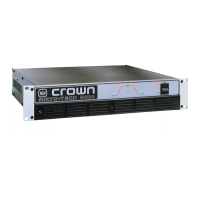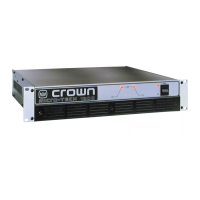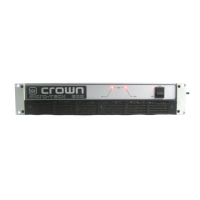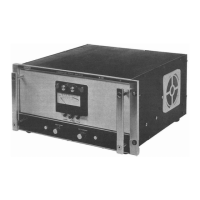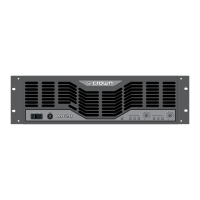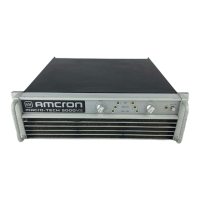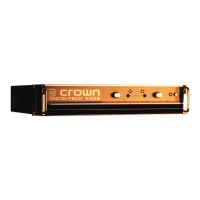Page 16
Micro-Tech 600/1200/2400 Power Amplifiers
conductors that could bisect the magnetic field.
Ground loops will also occur when the input and out-
put grounds are tied together. DO NOT CONNECT THE
INPUT AND OUTPUT GROUNDS TOGETHER. Tying
the input and output grounds together can also cause
feedback oscillation from the load current flowing in
the loop. To avoid this problem use proper grounding,
isolate the inputs, and isolate other common AC de-
vices. If necessary, the input phone jack grounds can
be isolated from the AC mains (chassis) ground with
the ground lift switch located on the back panel of the
amplifier (see Figure 2.2 and Section 4.4).
3.3.5 Output Connection
Consider the power-handling capacity of your load be-
fore connecting it to the amplifier. Crown is not liable for
damage incurred at any time due to any load being
overpowered. The use of loudspeaker protection fuses
is highly recommended (see Section 3.3.6). Also,
please pay close attention to the precautions in Sec-
tion 4.1.
excellent damping factor can easily be negated by us-
ing insufficient loudspeaker cables.
Use the nomograph and the procedure that follow to
find the recommended American Wire Gauge (AWG)
or resistance per 1000 feet of wire for your system.
Use Good Connectors
1. To prevent possible short circuits, insu-
late exposed loudspeaker cable connectors.
2. Do not use connectors that might acci-
dentally tie conductors together when mak-
ing or breaking connections (for example, a
standard three-wire stereo phone plug).
3. Never use connectors that can be
plugged into AC power receptacles.
4. Avoid using connectors with low current-
carrying capacity.
5. Do not use connectors that have any ten-
dency to short.
HOW TO DETERMINE
APPROPRIATE WIRE GAUGE
It is important to use loudspeaker cables with sufficient
gauge (thickness) for the length being used. The resis-
tance introduced by inadequate cables will reduce
both the output power and the motion control of the
loudspeakers. The latter problem occurs because the
damping factor decreases as cable resistance in-
creases. This is very important because the amplifier’s
40
30
20
15
10
9
8
7
6
5
4
3
2
1
2
5
10
20
50
100
.04
.06
.1
.2
.4
.6
1
2
4
6
10
20
40
8000
Ohms/1000 Feet
(305 Meters)
AWG (American
Wire Gauge)
Feet Meters
5000
1000
500
100
50
10
5
1
.5
.1
.05
.01
#28
#26
#24
#22
#20
#18
#16
#14
#12
#10
#8
#6
#4
#2
#0
#00
#0000
R
L
Load
Resistance
(Ohms)
R
L
R
S
Damping
Factor
R
S
Source
Resistance
(Ohms)
Two
Conductor
Cable
Copper
Wire
Example Shown:
Load Resistance = 8 ohms
Desired Damping Factor = 500
Source Resistance = 0.016 ohms
Cable Length = 10 feet (3.1 meters)
Recommended Wire: #8 AWG or equivalent
wire with 1.75 ohms or less resistance per
1000 feet (305 meters).
1
0.5
200
500
1,000
2,000
20,000
5,000
10,000
.01
.001
.02
.004
.006
.002
.0004
.0006
.0002
0.3
1.5
0.6
3.1
6.1
15.3
30.5
61.0
152.5
305.0
610.0
1525
1
5
2
10
20
50
100
200
500
1000
2000
5000
.0002
0.6
0.7
0.8
1.5
0.9
Fig. 3.13 Wire Size Nomograph
